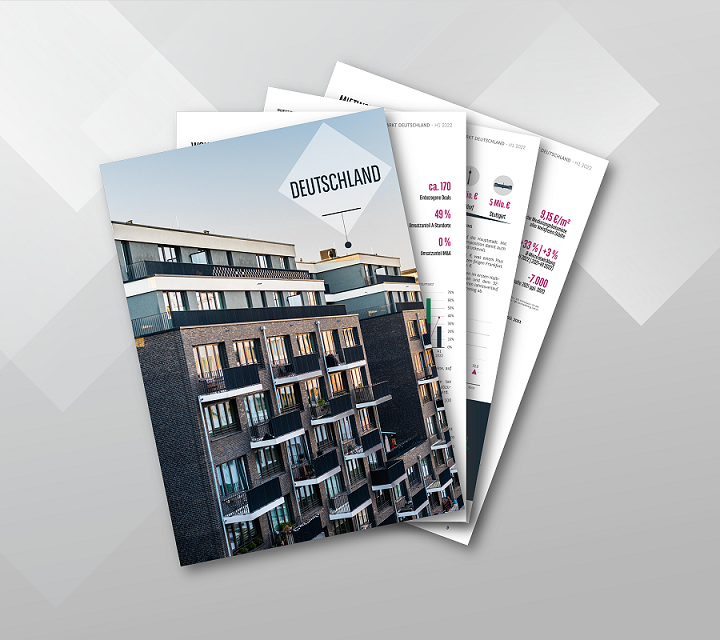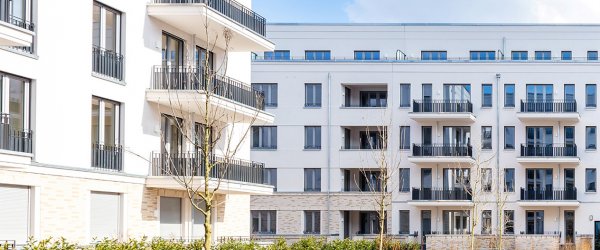Trends and insights of the residential market in Germany
The underlying conditions on the capital markets and consequently on German housing markets changed noticeably in the course of the first half of 2022. The war in Ukraine, exploding energy costs, a historically high rate of inflation and continuing supply bottlenecks are to some extent mutually dependent and exacerbating factors. Consequently, financing costs for real estate investments have increased considerably. Due to strong inflation, significantly impacted by high energy and food costs, central banks have been forced to raise key and refinancing interest rates in order to reduce pressure forcing pripces upward.
CONTENTS AT A GLANCE
-
Prologue [»]
-
Residential investment market Germany
-
Rental housing market Germany
-
Market data on major German cities
-
Factsheets on 110 cities

CHANGING UNDERLYING CONDITIONS FOR HOUSING MARKETS
-
The underlying conditions on the capital markets and consequently on German housing markets changed noticeably in the course of the first half of 2022. The war in Ukraine, exploding energy costs, a historically high rate of inflation and continuing supply bottlenecks are to some extent mutually dependent and exacerbating factors. Consequently, financing costs for real estate investments have increased considerably. Due to strong inflation, significantly impacted by high energy and food costs, central banks have been forced to raise key and refinancing interest rates in order to reduce pressure forcing prices upward. Accordingly, in July 2022, the ECB raised the key interest rate by 50 basis points to 0.50% for the first time in over a decade. In the face of record inflation, this was followed in September by the biggest interest rate hike since the introduction of the euro, at +75 basis points to 1.25%.
INCREASED FINANCING COSTS
-
After the outbreak of war in the Ukraine at the end of February, financing conditions on the capital markets changed markedly and swiftly, and the development of swap rates was a striking reflection of the financial world's expectations. 10-year mid-swaps rose at great pace in the spring of 2022 and have currently reached a high of 2.7%. This has made financing significantly more expensive for institutional investors.
-
Relatively strong and short-term fluctuations in recent swap rates underline the fact that current developments are also marked by great uncertainties on the financial markets, whilst at the same time expectation of long term rising interest rates is becoming more firmly established. An indication of this is the Euribor forward curves, which anticipate an increase of 220 basis points for the 3-month Euribor within the next 10 years, to a good 3%.
CONSTRUCTIONS COSTS CONTINUE TO RISE SIGNIFICANTLY
-
An additional factor that will significantly shape markets both current and especially future is the continued increase in construction costs. In May 2022, they rose by 17.6% for conventionally constructed residential buildings compared to the same month of the previous year. This is the highest year-on-year increase since May 1970 (+18.9% compared to May 1969). The decisive factors here are both high inflation rates and the material bottlenecks that continue to be observed due to disrupted supply chains, especially internationally.
-
Project developers, in particular, are now facing significant challenges. In order to operate economically, they will have little choice but to consider the extensive increase in production costs in their pricing. Against this backdrop of rising construction and financing costs, the sales environment is accordingly more difficult than in previous years.
DECLINING CONSTRUCTION ACTIVITY LIKELY
-
The background of these developments begs the question as to how construction activity and supply will develop in the future. From today's perspective, it is highly probable that construction volume will decrease, as many project developers adopt a wait-and-see attitude, at least for a while, due to the difficulty in calculating risks regarding the further direction of costs and purchase prices. This can already be seen to some extent in the data available so far on building permits in 2022. Although subject to a certain time lag between changing overall conditions and adjusted project planning is to be expected, building permits issued for housing in Germany were down year-on-year in both June (-8 %) and July (-3 %). In addition, it must be considered that a number of projects with existing building permits were put on hold or abandoned. Currently, there are many indications that these trends will continue.
-
Simultaneously, there are many indications that demand for housing is currently shifting from buying to renting. According to ImmoScout24's 'WohnBarometer', demand for properties to buy fell by 18% nationwide in July, while demand for rental housing rose by 4%. For cities such as Berlin (+31 %) and Munich (+17 %), significantly higher values are listed for rental applications. Demand for rental apartments currently exceeds supply, especially in existing housing stock, which could have an indirect influence on the development of purchase prices in the owner-occupier segment.
-
An examination of the development of supply in the owner-occupied housing market makes it clear that supply of existing housing has recently risen significantly. Our analysis shows that in the second quarter of 2022 more than 55,000 existing owner-occupied properties were on offer in all independent cities. This figure is 35% higher than the quarterly average since 2017. One possible explanation for this is that some owners are currently seeking to sell their flats while prices are still high, as they expect prices to fall in the future.
-
The situation in the new-build apartment segment is different. If project developers are no longer able to generate sufficient profit at existing prices, with more cost increases in sight (construction costs, land prices, inflation), a very significant decline in building completions is to be expected. This is especially true in small and medium-sized towns with correspondingly lower purchase prices. The result would be a significant supply bottleneck in the new-build segment, coupled with high excess demand. Such a market situation has been known to lead to price increases again in the medium term.
RENTAL DEMAND CONTINUES TO RISE
-
Demand for rental housing is expected to continue rising, meaning that the current surplus of demand is likely to persist in the medium term and may even increase. This assessment is based on a number of different factors, all of which have the effect of increasing demand.
-
These include further population growth in particularly sought-after major German cities and student towns up to 2035, as well as a considerable surge in demand driven by war refugees. The trend towards smaller households is also likely to continue, increasing demand.
-
Furthermore, consideration must be given that due to higher financing costs, elements of the target group for owner-occupied apartments will disappear, becoming new demand drivers for the rental markets.
FURTHER RENT GROWTH IN THE MEDIUM TERM
-
Continuing surplus of demand, likely to increase even more as new construction volumes decline, will very likely lead to further rent increases. Although high inflation and the sharp rise in energy costs will act as a brake on growth in the short term, tenants' incomes will also rise at the same time due to substantial wage increases. Overall rent trends are likely to be more differentiated between different locations and market segments than in recent years.
-
Particularly in popular large and expanding cities, the supply bottleneck will consolidate or even worsen against the backdrop of a growing population, meaning that rents can also be expected to rise in the medium term. It remains to be seen whether the development will be more moderate than in recent years. One indication of this assessment is the current development of rents in A-locations. In the first half of 2022, asking prices in existing stock rose by an average of 1.7%, and in the new-build segment by as much as 2.5%.
APARTMENTS REMAIN AN ATTRACTIVE INVESTMENT
-
The comments so far show that the new circumstances in the housing markets raise a number of questions that cannot yet be answered conclusively, and that future developments will probably be less coherent and uniform than in the past. Regardless of this, however, it is also clear that apartments remain an attractive investment for both private and, especially, institutional investors.
-
This is supported, among other things, by excess demand on the rental markets, which will continue to guarantee stable cash flows, a still discernible potential for rent increases and, last but not least, a hedge against inflation that exists, at least to a certain extent, compared to other asset classes.
KEY TAKEAWAYS
- Circumstances on the capital market have changed noticeably in the first half of 2022. Increased financing costs, further noticeable increases in construction costs, strong growth in energy costs and record-breaking inflation pose new challenges for all market participants.
- A trend towards slightly falling purchase prices can be seen in transactions with multi-family housing inventory, primarily reflecting the higher financing costs for institutional investors.
- Due to further increases in construction costs, alongside uncertainty about the development of purchase prices, the volume of construction completions is very likely to decrease significantly.
- Excess demand on the rental housing market will continue in the medium term and the pressure on the rental market will tend to increase. The main drivers of this development are the forecasted demographic growth and higher financing costs, which mean that for many people it is simply no longer possible to become owner occupiers.
- Rents are likely to continue rising, albeit at a more moderate pace than in recent years and with greater regional differentiation.
- Stable cash flows and potential for rent increases make residential investment a very attractive asset class.
